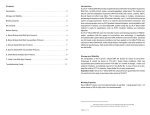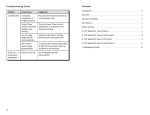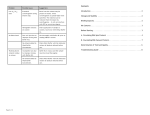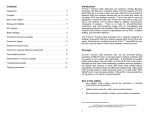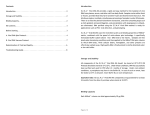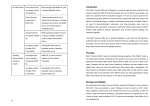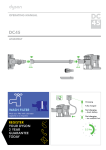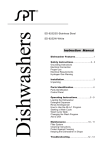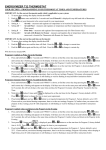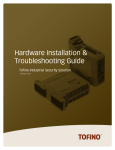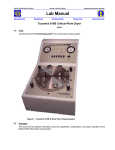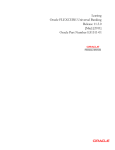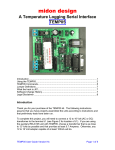Download Contents Introduction
Transcript
Contents Introduction . . . . . . . . . . . . . . . . . . . . . . . . . . . . . . . . . . . . . . . . . . . . . . . . . . . . . 2 Storage and Stability . . . . . . . . . . . . . . . . . . . . . . . . . . . . . . . . . . . . . . . . . . . . . . 2 Binding Capacity . . . . . . . . . . . . . . . . . . . . . . . . . . . . . . . . . . . . . . . . . . . . . . . . . 2 Kit Contents . . . . . . . . . . . . . . . . . . . . . . . . . . . . . . . . . . . . . . . . . . . . . . . . . . . . 3 Before Starting . . . . . . . . . . . . . . . . . . . . . . . . . . . . . . . . . . . . . . . . . . . . . . . . . . 3 A. Blood & Body fluid DNA Spin Protocol . . . . . . . . . . . . . . . . . . . . . . . . . . . . . . 4 B. Blood & Body fluid DNA Vacuum/Spin Protocol . . . . . . . . . . . . . . . . . . . . . . . 5 C. Buccal Swab DNA Spin Protocol . . . . . . . . . . . . . . . . . . . . . . . . . . . . . . . . . . 7 Introduction E.Z.N.A.™ Blood DNA Kit provides a rapid and easy method for the isolation of genomic DNA from 1 :l-250 :l fresh, frozen, and anticoagulated whole blood. The method can also be used for preparation of genomic DNA from buffy coat, serum, plasma, saliva, Buccal Swab and other body fuilds. The kit allows single or multiple, simultaneous processing of samples in under 30 minutes. Normally, up to 1 ml of whole blood can be used in a single experiment. There is no need for phenol/chloroform extractions, and time-consuming steps such as CsCl gradient ultracentrifugation, and precipitation with isopropanol or ethanol, are eliminated.DNA purified using the E.Z.N.A® Blood DNA method is ready for applications such as PCR*, Southern blotting, and restriction digestion. E.Z.N.A.® Blood DNA Kit uses the reversible nucleic acid-binding properties of HiBind® matrix, combined with the speed of mini-column spin technology. A specifically formulated buffer system allows genomic DNA 30-60 kb to bind to the matrix. Samples are first lysed under denaturing conditions and then applied to the HiBind® DNA spin columns to which DNA binds, while cellular debris, hemoglobin, and other proteins are effectively washed away. High quality DNA is finally eluted in sterile deionized water or low salt buffer. D. Buccal Swab DNA Vacuum/Spin Protocol . . . . . . . . . . . . . . . . . . . . . . . . . . . 8 E. Dried Blood Samples Spin Protocol . . . . . . . . . . . . . . . . . . . . . . . . . . . . . . . . 9 F. Buffy Coat DNA Spin Protocol . . . . . . . . . . . . . . . . . . . . . . . . . . . . . . . . . . . 10 Troubleshooting Guide . . . . . . . . . . . . . . . . . . . . . . . . . . . . . . . . . . . . . . . . . . . 11 Revised March 2009 Storage and Stability All components of the E.Z.N.A.® Blood DNA Kit, except the OB Protease should be stored at 22oC-25oC. Once reconstituted in water, OB Protease must be stored at -20oC. Under these conditions, DNA has successfully been purified and used for PCR after 24 months of storage. Under cool ambient conditions, a precipitate may form in the Buffer BL. In case of such an event, heat the bottle at 37oC to dissolve. Store Buffer BL at room temperature. Expiration Date: All E.Z.N.A.® Blood DNA Kit components are guaranteed for at least 24 months from the date of purchase when stored at 22-25oC. Binding Capacity Each HiBind™column can bind approximately 30 :g DNA. Using greater than 1 ml whole blood or 250 :l buffy coat is not recommended. * The PC R process i s c o ve r ed b y U . S . P a t e n ts 4 ,6 8 3 , 1 95 a n d 4 ,6 8 3 , 2 02 (and international equivalents) owned by Hoffmann-LaR oche, Inc. Page 2 of 12 A. Blood & Body Fluid DNA Spin Protocol Kit Contents Product No. D3392-00 D3392-01 D3392-02 5 Preps 50 Preps 200 Preps 5 50 200 15 150 600 Buffer BL 5 ml 20 ml 60 ml Buffer HB 5 ml 30 ml 110 ml DNA Wash Buffer 5 ml 20 ml 3 x 20 ml Elution Buffer 5 ml 40 ml 160 ml 200 :l 1.8 ml 7 ml OB Protease 3 mg 30 mg 120 mg User Manual 1 1 1 Purification times HiBind™ DNA Mini columns 2 ml Collection Tubes Protease Storage Buffer Buffer BL contains a chaotropic salt. Use gloves and protective eyeware when handling this solution. Materials and equipments Supplied by User # # # # NOTE: The procedure below has been optimized for use with FRESH or FROZEN blood samples 1 to 250 :l in volume. Anticoagulated blood, Saliva, Serum, Buffy Coat or other Body Fluid can also be used. In addition, # 107 leukocytes or cultured cells may be used with this procedure. For DNA extraction from tissue and mouse tail we suggest using the E.Z.N.A.® Tissue DNA Kit (product number D3495 and D3496). To isolate viral RNA from serum or other non-cellular body fluids use E.Z.N.A.® Viral RNA Kit. Bring samples and OB Protease solution to room temperature and have a water bath equilibrated to 65oC. Preheat an aliquot of Elution Buffer (approximately 0.5 ml per sample) at 65oC. Carry out all centrifugation steps at room temperature. 1. Add sample to a sterile microcentrifuge tube and bring the volume up to 250 :l with 10 mM Tris-HCl, PBS, or Elution Buffer provided. 2. Add 25 :l OB Protease and 250 :l of Buffer BL. Vortex at maxi speed for 15s to mix thoroughly. If RNA-free genomic DNA is required, add 5:l RNase A (50mg/ml) to each sample. 3. Incubate sample at 65oC for 10 min. 4. Briefly vortex the tube once during incubation. 5. Add 260 :l of absolute ethanol (room temperature, 96-100%) to lysate and vortex at maxi speed for 20s to mix thoroughly. Briefly centrifuge the tube to collect any drops from the inside of the lid. 6. Assemble an HiBind® DNA Mini column in a 2 ml collection tube (provided). Transfer the lysate from step 5 into the column and centrifuge at 8,000 x g for 1 min to bind DNA. Discard the collection tube and flow-through liquid. 7. Place the column into a second 2 ml tube (provided) and wash by pipetting 500 :l of Buffer HB. Centrifuge at 8,000 x g for 1 min. Again, Discard flow-through liquid and reuse the collection tube for next step. Before Starting I M P OR T AN T 1 2 Reconstitute OB Protease in 150 :l (5 preps) 1.5ml (50preps) or 6.0 ml (200 preps) Protease Storage Buffer. Vortex vial briefly prior to use. We recommend that you aliquot and store vials of reconstituted protease at -20oC. DNA Wash Buffer must be diluted with absolute ethanol (96-100%) as follows: D3392-00 Add 20 ml absolute ethanol D3392-01 Add 80 ml absolute ethanol D3392-02 Add 80 ml absolute ethanol per bottle Store diluted DNA Wash Buffer at room temperature All centrifugation steps must be carried out at room temperature. Page 3 of 12 Tabletop microcentrifuge and sterile 1.5 ml tubes. Water bath - set to 65°C. Ethanol - approximately 0.3 ml per sample. RNase A - Prepare a stock solution of RNase A at 50 mg/ml. Page 4 of 12 8. Place the column into a same 2 ml tube from step 7 and wash by pipetting 700 :l of DNA Wash Buffer diluted with ethanol. Centrifuge at 8,000 x g for 1 min. Again, dispose of collection tube and flow-through liquid. Note that DNA Wash Buffer is provided as a concentrate and must be diluted with absolute ethanol as indicated on the bottle or page 3. If refrigerated, the diluted wash buffer must be brought to room temperature before use. Material and equipments supplied by user # Tabletop microcentrifuge and sterile 1.5 ml tubes # Vacuum Manifold # Water bath - set to 65°°C. # Ethanol -approximately 0.3 ml per sample. # RNase A - Prepare a stock solution of RNase A at 50mg/ml. 1. Prepare the lysate by following step 1-5 of Protocol A, Spin protocol on page 4. 2. Insert the HiBind® DNA Mini column into the vacuum manifold. Carefully apply the lysate to an HiBind® DNA column. Turn on the vacuum source to draw all liquid through the column. Turn off the vacuum. Note: If the lysate has difficulty to pass through the column at this stage. Place the column into a collection tube (supplied). Close the lid and centrifuge at 8000 x g for 5 minutes or until all liquid pass through the column. Place the column into another collection tube (supplied) and continue step 7 of the spin protocol. 9. Using a new collection tube, wash the column with a second 700 :l of DNA Wash Buffer and centrifuge as above. Discard flow-through and re-use the collection tube for next step. 10. Place the empty column into the same 2 ml collection tube form step 9, centrifuge at maximum speed (15,000 x g) for 2 min to dry the column. This step is crucial for ensuring optimal elution in the following step. 11. Place the column into a sterile 1.5 ml microfuge tube and add 100-200 :l of preheated (65oC) Elution Buffer. Allow tubes to sit for 5 min at room temperature. 3. Pipet 500 :l of Buffer HB into the column. Turn on the vacuum source to draw all liquid through the column. Turn off the vacuum. 12. To elute DNA from the column, centrifuge at 8,000 x g for 1 min. Retain flowthrough containing the DNA. Place column into a second 1.5 ml tube. Elute DNA again as step 11-12. Discard column and store the eluted DNA at -20°C. 4. Wash the column by pipetting 750 :l of DNA Wash Buffer diluted with ethanol into the column. Turn on the vacuum source to draw all liquid through the column. Turn off the vacuum. Note: Each elution typically yields 60%-70% of the DNA bound to the column. Thus two elution generally give >90%. However, increasing elution volume reduces the concentration of the final product. To obtain DNA at higher concentrations, elution can be carried out using 50 :l to 100 :l Elution Buffer. Volumes lower than 50 :l greatly reduce yields. Alternatively use the first eluate to perform the second elution. 5. Close the lid of HiBind® DNA column, remove it from the vacuum manifold. Insert the column into a collection tube (supplied) and centrifuge at 15,000 x g for 2 minute to completely dry the column. 6. Elute DNA as Step 11-12 on page 5. If necessary the DNA can be concentrated. Add sodium chloride to a final concentration of 0.1 M followed by 2 x volume of absolute (100%) ethanol. Mix well and incubate at -20oC for 10 min. Centrifuge at 10,000 x g for 15 min and discard supernatant. Add 700 :l of 80% ethanol and centrifuge at 10,000 x g for 2 min. Discard supernatant, air dry the pellet (2 min) and resuspend DNA in 20 :l sterile deionized water or 10 mM Tris-HCl, pH 8. The expected yield from 250 :l blood is approximately 4-12 :g DNA. C. Buccal Swab DNA Spin Protocol Imp ortan t No te: • B. Blood & Body Fluid DNA Vacuum/Spin Protocol Page 5 of 12 Due to the increased volume of Buffer BL that required for buccal swab protocol, Page 6 of 12 • with absolute ethanol as indicated on the bottle and page 3. If refrigerated, the diluted wash buffer must be brought to room temperature before use. fewer preparation can be performed. Additional BL Buffer can be purchased separately. (Product # BL-100). All centrifugation steps are carried out at room temperature. 9. Place the column into a same 2 ml collection tube from step 8. Centrifuge at 15,000 x g for 2 minutes to completely dry the HiBind® DNA Mini column. Discard the flow-through and the collection tube. 10. Place the column into a sterile 1.5 ml microfuge tube and add 50-100 :l of preheated (65°C) Elution Buffer. Allow tubes to sit for 5 min at room temperature. 11. To elute DNA from the column, centrifuge at 8,000 x g for 1 min. Retain flowthrough containing the DNA. Place column into a second 1.5 ml tube. Elute DNA again as step 10-11. Discard column and store the eluted DNA at -20°C. Material and Equipments required # # # # # Tabletop microcentrifuge and sterile 1.5 ml tubes Water bath - set to 65°C PBS Buffer Absolute Ethanol - approximately 0.3 ml per sample RNase A(Optional) - Prepare a stock of RNase A at 50mg/ml 1. Place the buccal swab in a 2 ml centrifuge tube. Add 500 :l PBS in the tube. If RNA-free DNA is required for downstream application, add 4 :l RNase A (50mg/ml) into the sample. 2. Add 25:l OB Protease and 500:l Buffer BL into sample. Mix by vortexing at maxi speed for 30s. 3. Incubate at 65°C for 10 minutes. Collect any liquid drop from lid by brief centrifugation. 4. Add 500:l absolute ethanol (room temperature, 96-100%) to the sample and mix by vortexing at maxi speed for 15 seconds. Collect any liquid drop from lid by brief centrifugation. 5. Carefully apply 750:l sample from step 4 into HiBind® DNA Mini column preinserted in a 2 ml collection tube (provided). Centrifuge at 8000 x g for 1 minute. Discard the flow-through and collection tube. 6. Place the column into a new 2 ml collection tube (provided). Carefully apply remaining sample from step 4 into HiBind® DNA column. Centrifuge at 8000 x g for 1 minute. Discard the flow-through and collection tube. 7. Place the column into a new 2 ml collection tube (provided). Add 500:l of HB Buffer into the column. Centrifuge at 8000 x g for 1 minute. Discard the flowthrough and reuse the collection tube in next step. 8. Place the column into a same 2 ml collection tube from step 7. Add 700:l of DNA Wash Buffer into the column. Centrifuge at 8000 x g for 1 minute. Discard the flow-through and reuse the collection tube in next step. Note that DNA Wash Buffer is provided as a concentrate and must be diluted Page 7 of 12 D. Buccal Swab DNA Vacuum/Spin Protocol Material and Equipments required # # # # # # Tabletop microcentrifuge and sterile 1.5 ml tubes Vacuum Manifold Water bath - set to 65°C PBS Buffer Absolute Ethanol - approximately 0.3 ml per sample. RNase A (Optional)- Prepare a stock of RNase A at 50 mg/ml. 1. Prepare Buccal Swab lysate by following step 1-4 of Spin Protocol on page 7. 2. Insert the HiBind® DNA column into the vacuum manifold. Carefully apply the lysate to an HiBind® DNA column. Turn on the vacuum source to draw all liquid through the column. Turn off the vacuum. Note: If the lysate has difficulty to pass through the column at this stage. Place the column into a collection tube (supplied). Close the lid and centrifuge at 8000 x g for 5 minutes or until all liquid pass through the column. Place the column into another collection tube (supplied) and continue step 7 of the spin protocol. 3. Apply remaining lysate into the column. Turn on the vacuum source to draw all liquid through the column. Turn off the vacuum. 4. Pipet 500 :l of Buffer HB into the column. Turn on the vacuum source to draw all liquid through the column. Turn off the vacuum. 5. Wash the column by pipetting 750 :l of DNA Wash Buffer diluted with ethanol Page 8 of 12 into the column. Turn on the vacuum source to draw all liquid through the column. Turn off the vacuum. 6. 7. Close the lid of HiBind® DNA column, remove it from the vacuum manifold. Insert the column into a collection tube (supplied) and centrifuge at 15,000 x g for 2 minute to completely dry the column. 7. Place the column into a same 2 ml tube from step 7 and wash by pipetting 700 :l of DNA Wash Buffer diluted with ethanol. Centrifuge at 8,000 x g for 1 min. Again, dispose of collection tube and flow-through liquid. 8. Using a new collection tube (provided), wash the column with a second 700 :l of DNA Wash Buffer diluted with ethanol and centrifuge as above. Discard flow-through and re-use the collection tube for next step. 9. Place the empty column into the same 2ml collection tube form step 8, centrifuge at maximum speed (15,000 x g) for 2 min to dry the column. This step is crucial for ensuring optimal elution in the following step. 10. Place the column into a sterile 1.5 ml microfuge tube and add 50-100 :l of preheated (65°C) Elution Buffer. Allow tubes to sit for 5 min at room temperature. 11. To elute DNA from the column, centrifuge at 8,000 x g for 1 min. Retain flowthrough containing the DNA. Discard column and store the eluted DNA at 20°C. Proceed Step 10-11of Baccul Swab DNA Spin Protocol on page 7-8. E. Dried Blood Samples DNA Spin Protocol The following protocol is designed for isolating genomic DNA from dry blood sample collected with filter paper or commercial blood collecting card. Material and equipments supples by user # Tabletop microcentrifuge and sterile 1.5 ml tubes # Water bath - set to 65°C # PBS Buffer # Absolute Ethanol - approximately 0.3 ml per sample. # RNase A (Optional) - Prepare a stock of RNase A at 50 mg/ml. 1. Cut or punch out the blood spot from the filter paper. (Up to 200 :l blood can be used for each spot.) Tear or cut filter into small pieces and place into a microfuge tube. 2. Add 250 :l PBS and incubate at 65oC for 1 hour. Vortex to mix every 20 min. 3. Add 25 :l OB protease and mix well. Incubate 30 min at 60°C with occasional mixing. 4. Centrifuge at 10,000 x g for 5 min at room temperature. Transfer the supernatant to a clean microfuge tube and add ONE volume of Buffer BL followed by ONE volume of absolute ehthanol. Vortex thoroughly to mix at maxi speed for 30s. Collect any drop from the lid by briefly centrifugation. Assemble an HiBind® DNA column in a 2 ml collection tube (provided). Transfer the lysate from step 4 into the column and centrifuge at 8,000 x g for 1 min to bind DNA. Discard the collection tube and flow-through liquid. 5. 6. Place the column into a second 2 ml tube and wash by pipetting 500 :l of Buffer HB. Centrifuge at 8,000 x g for 1 min. Again, Discard flow-through liquid and reuse the collection tube for next step. Page 9 of 12 Blood spots from finger pricks usually contain no more than 50 :l blood and yield approximately 500 ng to 1 :g DNA. This is usually sufficient for PCR analysis. To obtain higher DNA concentrations, elute with 50 :l preheated Elution Buffer or TE and repeat with the first eluate. F. Buffy Coat DNA Spin Protocol The buffy coat fraction of whole blood is enriched with WBC, and usually gives at least 5-fold more DNA than the same volume of blood. To prepare buffy coat from fresh whole blood, simply centrifuge the sample at 3,000-4,000 x g for 10 min at room temperature. Three layers should be obtained with plasma in the upper layer, leucocytes in the middle layer (buffy coat), and erythrocytes in bottom layer. Carefully aspirate the plasma making sure not to disturb the layer of concentrated leukocytes. The buffy coat can be drawn off with a pipette and used directly in the E.Z.N.A.® Blood DNA Protocol, or frozen at -70oC for storage. Troubleshooting Guide Page 10 of 12 Problem Possible Cause Suggestions Problem Possible Cause Suggestions C lo gg ed Co lu m n Inco m plete lysis A d d th e c or re c t v o lu m e o f B u ff er B L N o D N A el uted Po or c ell lysis du e to M ix tho rou gh ly with Bu ffer B L p rior to and incubate for specified time at im pro pe r m ixing with load ing H iBin d™ colu m n. 70 o C. It may be necessary to extend Buffer BL. incubation time by 10 min. Absolute ethanol not Sample too large If using more than 250 : l of blood, added to Buffer BL. Before applying sample to column, an aliquot of Buffer BL/ethanol must be added. See protocol above. in c re a se v olu m e s o f O B Protease/Proteinase K, Buffer BL, and No eth an ol ad de d to Dilute Wash Buffer with the indicated Wash Buffer volum e of a bso lute eth ano l before Concentrate. use. W as hi ng leav es Incomplete lysis due Bu ffer B L is v isco us an d th e sa m ple co lore d re sid ue in to improper mixing m us t be m ixed tho rou gh ly. isop rop an ol. P as s aliq uo ts of ly sa te thro ug h o ne colu m n su cce ssiv ely. Sample too viscous Divide sample into multiple tubes, adjust volume to 250 : l w ith 10 m M Tris -HC l. Lo w D NA yield c olu m n with Buffer BL. C lo gg ed co lu m n See above No eth an ol ad de d to Dilute Wash Buffer with the indicated Poor elution Repeat elution or increase elution Wash Buffer volum e of a bso lute eth ano l before volum e (se e no te on pag e 4). Concentrate. use. El uted m ateri al has Sample volume too Reduce sample volume and follow r ed/br ow n col or large. directions Incubation of column at 70 o C fo r 5 m in with Elution Buffer may increase yield s. Improper washing Wash Buffer Concentrate must be diluted with absolute (100%) ethanol as specified on page 5 before use. Buffy Coat used With Buffy Coat samples, use absolute ethanol rather than isopropanol in step 5, page 6. Resin from the column may be L o w A 2 6 0 /A 2 8 0 Extended ratio centrifugation during present in eluate. Avoid centrifugation elution step. at speeds higher than specified. The material can be removed from the eluate by centrifugation — it will not interfere with PCR or restriction digests. Po or c ell lysis du e to R e pe at th e p ro ce du re , th is tim e incomplete mixing m ak ing s ere to vo rtex th e sa m ple w ith w it h B u ff er B L Buffer BL imm ediately and com pletely. Hemoglobin remains After application of sample to column, o n c olu m n wash once with 300 : l Buffer AL. Page 11 of 12 Page 12 of 12 Hemoglobin remains A fte r a pp ly in g s am p le , w as h c olu m n on column. once with 300 : l Buffer BL.






